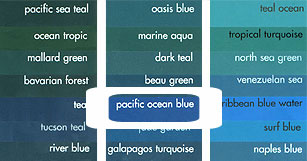
 |
| Our Data...Ocean Color |
|
|
Cruise Activity #3: Summarize our data on ocean color. A printable Ocean Color Data Sheet is provided to guide your note-taking. If you do not have Adobe Acrobat or another way to view PDF files, click here to download the free software. |
| The color of the ocean can tell us a lot about what is in the water. Different constituents (e.g., particles) found in the ocean absorb and scatter light differently; it is the sum of scattering and absorption by all these constituents that impart ocean color. Clean, clear water without a lot of particles appears blue; however, water that contains phytoplankton, sediment and organic matter can appear green, yellow, brown and even red! One way we can describe ocean color is to compare it to colors on paint cards that you can pick up at the local hardware store. We can use this technique to describe the ocean color at our three stations. |
|
|
Our
continental shelf station was centered at 42° 38'
N / 69° 48' W at Wilkinson Basin within the Gulf of Maine. Sunny weather
revealed green water whose closest paint match was "Bavarian Forest."
|
 |
|
|
Our upwelling station was centered at 41°N / 67° 40' W on Georges Bank. Foggy skies made it difficult to distinguish the water color but we all agreed the closest paint match was "Marine aqua." |
|
|
|
Our
open ocean station was centered at 36°50'N / 70°W
in the Sargasso Sea. Although it is difficult to convey the beautiful
color of open ocean water, the closest paint match was probably "Pacific
Ocean Blue." |
 |
| (To read more about ocean optics, visit Bigelow's "Toxic and Harmful Algal Blooms" web site or the Smithsonian Environmental Research Center's "What is hydrologic optics?" web site.) |